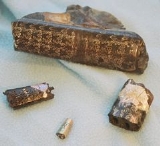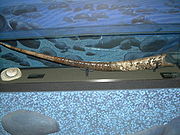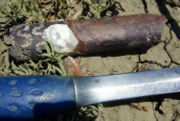
Baculite
Encyclopedia
Baculites is an extinct cephalopod genus with a nearly straight shell that is included in the heteromorph ammonites
. The genus, which lived worldwide throughout the Late Cretaceous
period, was named by Lamarck in 1799
 The adult shell of Baculites is generally straight and may be either smooth or with sinuous striae or ribbing that typically slant dorso-ventrally forward. The aperture likewise slopes to the front and has a sinuous margin. The venter is narrowly rounded to acute while the dorsum in more broad. The juvenile shell, found at the apex, is coiled in one or two whorls and described as minute, about a centimeter in diameter. Adult Baculites ranged in size from about seven centimeters (Baculites larsoni) up to two meters in length.
The adult shell of Baculites is generally straight and may be either smooth or with sinuous striae or ribbing that typically slant dorso-ventrally forward. The aperture likewise slopes to the front and has a sinuous margin. The venter is narrowly rounded to acute while the dorsum in more broad. The juvenile shell, found at the apex, is coiled in one or two whorls and described as minute, about a centimeter in diameter. Adult Baculites ranged in size from about seven centimeters (Baculites larsoni) up to two meters in length.
As with other ammonites, the shell consisted of a series of camerae, or chambers, that were connected to the animal by a narrow tube called a siphuncle by which gas content and thereby buoyancy could be regulated in the same manner as Nautilus
does today. The chambers are separated by walls called septa. The line where each septum meets the outer shell is called the suture or suture line. Like other true ammonites
, Baculites have intricate suture patterns on their shells that can be used to identify different species.
One notable feature about Baculites is that the males may have been a third to a half the size of the females and may have had much lighter ribbing on the surface of the shell.
The shell morphology of Baculites with slanted striations or ribbing, similarly slanted aperture, and more narrowly rounded to acute keel-like venter points to its having had a horizontal orientation in life as an adult. This same type of cross section is found in much earlier nautiloids such as Bassleroceras
and Clitendoceras
from the Ordovician
period, which can be shown to have had a horizontal orientation. In spite of this, some researchers have concluded that Baculites lived in a vertical orientation, head hanging straight down, since lacking an apical counterweight, movement was largely restricted to that direction. More recent research, notably by Gerd Westermann, has reaffirmed that at least some Baculites species if fact lived in a more or less horizontal orientation
From shell isotope studies, it is thought that Baculites inhabited the middle part of the water column, not too close to either the bottom or surface of the ocean. In some rock deposits Baculites are common, and they are thought to have lived in great shoals. However, they are not known to occur so densely as to be rock-forming, as do certain other extinct, straight-shelled cephalopods (e.g., orthocerid nautiloids
).
Baculites fossils are very brittle and almost always break. They are most commonly found broken in half or several pieces, usually along suture lines. Individual chambers found this way are sometimes referred to as "stone buffaloes" (due to their shapes), though the Native-American attribution typically given as part of the story behind the name is likely apocryphal.
Baculites and related Cretaceous
straight ammonite
cephalopods are often confused with the superficially similar orthocerid nautiloid
cephalopods. Both are long and tubular in form, and both are common items for sale in rock shops (often under each others' names). Both lineages evidently evolved the tubular form independently, and at different times in earth history. The orthocerid nautiloid
s lived much earlier (common during the Paleozoic
Era and extinct by the end of the Triassic
Period) than Baculites (Late Cretaceous
Period only). The two types of fossils can be distinguished by many features, most obvious among which is the suture line: it is simple in orthocerid nautiloids and intricately folded in Baculites and related ammonoids.
Studies on exceptionally preserved specimens have revealed a radula
by synchrotron
imagery. The results suggest that Baculites fed on pelagic zooplankton
(as suggested by remains of a larval gastropod and a pelagic isopod inside the mouth).

 Numerous species have been designated from the fossil record since the initial description of the genus in 1799.
Numerous species have been designated from the fossil record since the initial description of the genus in 1799.
Ammonitida
The Ammonitida is an order of more highly evolved ammonoid cephalopods from the Jurassic and Cretaceous time periods, commonly with intricate ammonitic sutures....
. The genus, which lived worldwide throughout the Late Cretaceous
Late Cretaceous
The Late Cretaceous is the younger of two epochs into which the Cretaceous period is divided in the geologic timescale. Rock strata from this epoch form the Upper Cretaceous series...
period, was named by Lamarck in 1799

As with other ammonites, the shell consisted of a series of camerae, or chambers, that were connected to the animal by a narrow tube called a siphuncle by which gas content and thereby buoyancy could be regulated in the same manner as Nautilus
Nautilus
Nautilus is the common name of marine creatures of cephalopod family Nautilidae, the sole extant family of the superfamily Nautilaceae and of its smaller but near equal suborder, Nautilina. It comprises six living species in two genera, the type of which is the genus Nautilus...
does today. The chambers are separated by walls called septa. The line where each septum meets the outer shell is called the suture or suture line. Like other true ammonites
Ammonitida
The Ammonitida is an order of more highly evolved ammonoid cephalopods from the Jurassic and Cretaceous time periods, commonly with intricate ammonitic sutures....
, Baculites have intricate suture patterns on their shells that can be used to identify different species.
One notable feature about Baculites is that the males may have been a third to a half the size of the females and may have had much lighter ribbing on the surface of the shell.
The shell morphology of Baculites with slanted striations or ribbing, similarly slanted aperture, and more narrowly rounded to acute keel-like venter points to its having had a horizontal orientation in life as an adult. This same type of cross section is found in much earlier nautiloids such as Bassleroceras
Bassleroceras
Bassleroceras is an elongate upwardly curved, exogastric, genus with the venter on the under side more sharply rouned than the dorsum on the upper...
and Clitendoceras
Clitendoceras
Clitendoceras is a member of the Endocerida from the Lower Ordovician with an elongate shell with a slight downward, endogastric, curvature and a siphuncle that lay along the ventral margin. Common for endocerids, the chambers are short and the septa close spaced with sutures sloping forward...
from the Ordovician
Ordovician
The Ordovician is a geologic period and system, the second of six of the Paleozoic Era, and covers the time between 488.3±1.7 to 443.7±1.5 million years ago . It follows the Cambrian Period and is followed by the Silurian Period...
period, which can be shown to have had a horizontal orientation. In spite of this, some researchers have concluded that Baculites lived in a vertical orientation, head hanging straight down, since lacking an apical counterweight, movement was largely restricted to that direction. More recent research, notably by Gerd Westermann, has reaffirmed that at least some Baculites species if fact lived in a more or less horizontal orientation
From shell isotope studies, it is thought that Baculites inhabited the middle part of the water column, not too close to either the bottom or surface of the ocean. In some rock deposits Baculites are common, and they are thought to have lived in great shoals. However, they are not known to occur so densely as to be rock-forming, as do certain other extinct, straight-shelled cephalopods (e.g., orthocerid nautiloids
Orthoceras
Orthoceras is a genus of extinct nautiloid cephalopod. This genus is sometimes called Orthoceratites. Note it is sometimes misspelled as Orthocera, Orthocerus or Orthoceros ....
).
Baculites fossils are very brittle and almost always break. They are most commonly found broken in half or several pieces, usually along suture lines. Individual chambers found this way are sometimes referred to as "stone buffaloes" (due to their shapes), though the Native-American attribution typically given as part of the story behind the name is likely apocryphal.
Baculites and related Cretaceous
Cretaceous
The Cretaceous , derived from the Latin "creta" , usually abbreviated K for its German translation Kreide , is a geologic period and system from circa to million years ago. In the geologic timescale, the Cretaceous follows the Jurassic period and is followed by the Paleogene period of the...
straight ammonite
Ammonite
Ammonite, as a zoological or paleontological term, refers to any member of the Ammonoidea an extinct subclass within the Molluscan class Cephalopoda which are more closely related to living coleoids Ammonite, as a zoological or paleontological term, refers to any member of the Ammonoidea an extinct...
cephalopods are often confused with the superficially similar orthocerid nautiloid
Nautiloid
Nautiloids are a large and diverse group of marine cephalopods belonging to the subclass Nautiloidea that began in the Late Cambrian and are represented today by the living Nautilus. Nautiloids flourished during the early Paleozoic era, where they constituted the main predatory animals, and...
cephalopods. Both are long and tubular in form, and both are common items for sale in rock shops (often under each others' names). Both lineages evidently evolved the tubular form independently, and at different times in earth history. The orthocerid nautiloid
Nautiloid
Nautiloids are a large and diverse group of marine cephalopods belonging to the subclass Nautiloidea that began in the Late Cambrian and are represented today by the living Nautilus. Nautiloids flourished during the early Paleozoic era, where they constituted the main predatory animals, and...
s lived much earlier (common during the Paleozoic
Paleozoic
The Paleozoic era is the earliest of three geologic eras of the Phanerozoic eon, spanning from roughly...
Era and extinct by the end of the Triassic
Triassic
The Triassic is a geologic period and system that extends from about 250 to 200 Mya . As the first period of the Mesozoic Era, the Triassic follows the Permian and is followed by the Jurassic. Both the start and end of the Triassic are marked by major extinction events...
Period) than Baculites (Late Cretaceous
Cretaceous
The Cretaceous , derived from the Latin "creta" , usually abbreviated K for its German translation Kreide , is a geologic period and system from circa to million years ago. In the geologic timescale, the Cretaceous follows the Jurassic period and is followed by the Paleogene period of the...
Period only). The two types of fossils can be distinguished by many features, most obvious among which is the suture line: it is simple in orthocerid nautiloids and intricately folded in Baculites and related ammonoids.
Studies on exceptionally preserved specimens have revealed a radula
Radula
The radula is an anatomical structure that is used by molluscs for feeding, sometimes compared rather inaccurately to a tongue. It is a minutely toothed, chitinous ribbon, which is typically used for scraping or cutting food before the food enters the esophagus...
by synchrotron
Synchrotron
A synchrotron is a particular type of cyclic particle accelerator in which the magnetic field and the electric field are carefully synchronised with the travelling particle beam. The proton synchrotron was originally conceived by Sir Marcus Oliphant...
imagery. The results suggest that Baculites fed on pelagic zooplankton
Zooplankton
Zooplankton are heterotrophic plankton. Plankton are organisms drifting in oceans, seas, and bodies of fresh water. The word "zooplankton" is derived from the Greek zoon , meaning "animal", and , meaning "wanderer" or "drifter"...
(as suggested by remains of a larval gastropod and a pelagic isopod inside the mouth).
Species


- Baculites anceps
- Baculites aquilaensis
- Baculites asper
- Baculites asperiformis
- Baculites baculus
- Baculites bailyi
- Baculites buttensis
- Baculites capensis
- Baculites chicoensis
- Baculites clinolobatus
- Baculites compressus
- Baculites crickmayi
- Baculites fairbanksi
- Baculites fuchsi
- Baculites grandis
- Baculites haresi
- Baculites incurvatus
- Baculites inornatus
- Baculites jenseni
- Baculites kirki
- Baculites knorrianus
- Baculites lechitides
- Baculites lomaensis
- Baculites mclearni
- Baculites meeki
- Baculites minerensis
- Baculites nugssuaqensis
- Baculites occidentalis
- Baculites obtusus
- Baculites ovatus
- Baculites pseudovatus
- Baculites rectus
- Baculites reesidei
- Baculites scotti
- Baculites subanceps
- Baculites teres
- Baculites undatus
- Baculites undulatus
- Baculites vaalsensis
- Baculites vertebralis

